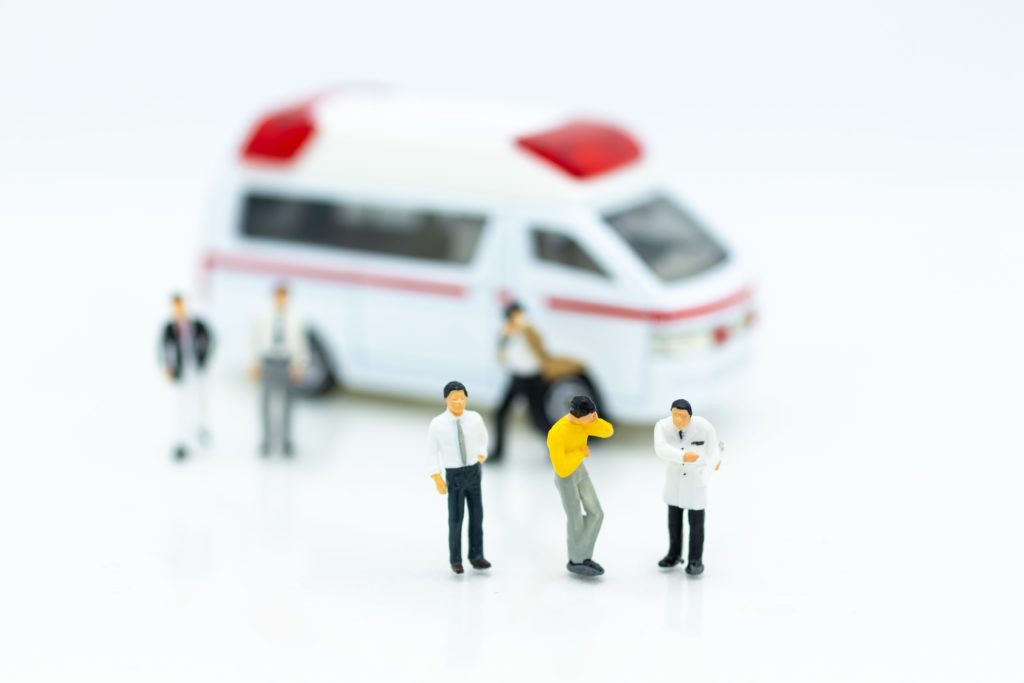Negligence is one person’s failure to take reasonable care to prevent causing an injury or death to another person. Negligence during medical transport is one specific type of negligence that affects the most vulnerable, and it happens more often than you might think.
What Is Negligence?
When people fail to act with the appropriate level of care, they are negligent. They might commit negligence through actions or omissions of action. In a legal case where a plaintiff sues a defendant for negligence, the court looks at whether the outcome was foreseeable. Did the person likely realize that their actions or omissions of action would conceivably result in harm to the person? Did they take any precautions available to them that might have eliminated or reduced that risk of harm? These questions help determine whether a person is guilty of negligence.
Every negligence case must consist of four elements:
- The existence of a legal duty owed the plaintiff by the defendant
- The breach of duty by the defendant
- An injury to the plaintiff
- Proof that the breach of duty caused the injury
Negligence is usually a tort rather than a crime. They result in personal injury lawsuits to get financial compensation. The same act can be both a tort and a crime, but these types of charges are handled separately. For example, leaving a loaded gun within reach of a small child might result in their shooting a visiting neighbor in the leg. The person who left the gun on the table was negligent. The neighbor can sue them for money to pay their medical bills, loss of income, and pain and suffering.
The law might also charge them with a misdemeanor or federal offense, depending on the state where they live. The same example shows why it is more difficult to prove that another person intended to cause harm to the victim. It is almost impossible to prove what was in the mind of the person who committed the negligence and caused the other person’s injury.
Medical Transport Negligence
Vehicle accidents happen every day, many of which are due to one or more person’s negligence. Failing to abide by the traffic laws, driving distracted, or not staying alert are some of the ways drivers are negligent. They have a duty of care to other drivers, passengers, bicyclists, and pedestrians to drive safely.
Emergency medical technicians (EMTs) have an even greater duty of care in the job they do. They provide medical transport to people who are injured and require immediate medical care. The treatment EMTs provide immediately after an injury or health crisis is critical to their outcome.
Gross negligence is another type of negligence that involves the lack of diligence or care, voluntary action, or an omission an EMT might make when providing emergency care. Some examples of gross negligence by an EMT include declining to treat or treating in a way that is counter to the standard situation. In some states, if the EMT was attempting to do the job correctly, they might not be vulnerable to lawsuits for negligence.
If an EMT gives you the wrong treatment or uses the wrong method to provide treatment, they may be liable. To win a lawsuit, you must prove that the wrongful treatment caused your injury or damages. In cases where medical treatment normally carries a higher risk of injury than normal, you must prove that the damage is more extensive and unreasonable than what is normal. One example of this type of scenario is implementing CPR to resuscitate a patient; they might break their ribs. If you want to prove that the EMT used excessive force or they performed CPR incorrectly, you must prove that the damage is unreasonable and beyond what is normal.
Something called “willful and wanton” might apply to some negligence cases, but it is very difficult to prove. If the EMTs refuse to provide treatment or medical transport for personal reasons, it is willful and wanton. For example, if a patient is gay, and they don’t approve of their lifestyle, then they failed to meet their duty of care over willful and wanton conduct.
In addition to negligence, the first responder might receive a ticket or criminal charges. A medical transport driver must obey the same traffic laws as any other driver on the road. If they break the law and cause an accident that injures the patient or someone else, they are liable for it.

Can I Sue a Medical Transport Company for Negligence In California?
Even if you’ve never needed an ambulance in your life, you assume they are just a phone call away if you ever do. You or another person might call for medical transport if you’ve been in a car wreck, have symptoms of a heart attack, or take a serious fall. You expect the driver and the staff to know what to do under any circumstances and provide you with the immediate care you need.
Imagine how it would feel if you didn’t make it to the hospital because of a second accident. What if the EMTs made a mistake in treating you at the scene or at the location where they picked you up. They might even refuse to treat you at all. Their actions or failure to act might cause you to endure more extensive injuries, require ore surgeries, or even suffer a permanent disability.
If the medical transport staff is negligent at the scene, you might have a valid legal case. It depends on several factors, including your state of residence, the type of mistake made, and the type of medical transport company they are.
All medical transport companies aren’t the same. Those that are designed strictly for transporting patients from place to place don’t have the same duty of care as ambulances that are staffed with EMT. These medical experts have more extensive training and a proportional duty of care.
Your rights also depend on whether the company was negligent, or they made a mistake. You have the burden of proof to show that another person with equivalent training and the same duty of care would not have made the same mistake.
Medical transport should be fast, efficient, and safe. In most cases, the person an ambulance transport is in serious medical need. If the EMTs are negligent, it might result in further injury. The case of Anna Kozlovsky v. Vitaliy Zilbershertyn and New Century Medical Transportation, Inc. is just one example of how serious the outcome of a medical transport negligence case can be.
On September 28, 2015, Anna Kozlovsky was a passenger in a medical transport van owned by New Century Medical Transportation, Inc. A company employee, Vitaliy Zilbershertyn, was driving the van. At the intersection of Santa Monica Boulevard and Beloit Avenue in the City of Los Angeles, the van collided with another vehicle.
The collision resulted in additional injuries to Kozlovsky’s spine that also required future surgery. Kozlovsky contended that Zilbershertyn ran a red light and was 100% at fault for the collision. Zilbershertyn contended that a third-party driver ran the red light and caused the collision. Furthermore, Zilbershertyn claimed that Kozlovsky wasn’t wearing her seat belt at the time of the collision and that she had only suffered bruising and strains/sprains to her neck and back as a result of the crash.
After the jury deliberated for only 5 hours, they came back with a verdict for $1.2 million to the plaintiff. But the negligence doesn’t always result from transportation. Sometimes it’s from the treatment or lack of treatment before or during the transport. EMTs are medical professionals who are expected to provide proper care. Some ways that they might be negligent include a failure to:
- Respond in a time-sensitive manner
- Identify potentially fatal conditions that require immediate treatment
- Bring or use the right equipment
- Adhere or evaluate the condition for the correct treatment
- Administer oxygen
- Maintain ambulance equipment
- Administer the appropriate medication
- Provide responsible driving to the hospital
TV shows often depict the urgency of calling an ambulance and transporting someone to the hospital. What they don’t focus on is the time the EMTs spend evaluating and treating the patient before transporting them. This time is just as important if not more so than the actual transport to the hospital. Depending on the person’s condition, the EMTs might give them medication or use equipment to stabilize them.
Some Responsibilities of the Medical Transport Team
EMTs are the first responders after an accident. They are trained to provide the first level of care to individuals after an accident. Some ways they might do this include:
- Spinal immobilization, applying splints, and controlling bleeding
- Measuring vitals including temperature, blood pressure, responsiveness, and respiratory rates
- Performing cardiopulmonary resuscitation
- Assessing airflow and opening nasopharyngeal and oropharyngeal airways
- Administering medications
- Applying a cervical collar or another stabilizing device
- Aiding with childbirth
Failing to perform any of these duties of care as needed results in negligence for which the medical transport team is liable.
Negligence also includes mistakes like failing to take the patient to the nearest receiving facility. Taking them to a different facility might result in a valuable loss of time that alters the patient’s outcome.
Handling them roughly, rolling or dropping them from the gurney, or driving recklessly might cause further injuries. Failing to support the person’s spine and neck, missing or misdiagnosing a condition are also common mistakes.
In California, EMTs operate under the standard procedures set forth by the California Emergency Medical Services Authority. This organization sets the guidelines for responders, develops standards for administering care, and coordinates public health, safety, and healthcare into a unified system of emergency medical care and disaster medical response.
Local EMS agencies and other certifying entities certify EMTs and Advanced EMTs at the county level.

Who Is Liable for Medical Transport Related Mistakes
When an EMTs negligence results in a person’s injury or wrongful death, who do you file the lawsuit against? It might not be as simple as straightforward as you think. Many hands play a role in the medical transport’s response, including the company that owns the vehicle and hired the driver. The facility that trained and certified the EMT. The party responsible for providing regular maintenance to the emergency vehicle, and whoever stocks and maintains the medical equipment in the truck all have a duty of care. Anyone or a combination of them might be guilty of negligence.
Imagine that a man performing some DIY projects at home falls all the ladder onto a solid concrete surface below. A serious neck injury restricts blood flow to his brain. The man’s wife calls 911 and tries to comfort her husband while they wait. It takes more than 20 minutes for the ambulance to arrive.
The EMTs carefully load the man into the ambulance and transport him to the hospital. They rush him to the emergency room of a hospital that is ten minutes farther from his home than the one where he normally goes. The ER staff evaluates his condition. They rush him into surgery to repair the neck injury. The patient survives the surgery, but with serious consequences that will require extensive treatment for the rest of his life.
An expert witness testifies that if the surgery had started 15 minutes sooner, the outcome would have been much different. He likely would have made a full recovery. In this case, the man and/or his wife could sue the EMT driver for making the call to go to a hospital that’s farther away. They could also sue the company that owns the EMT service, or possibly the hospital. It all depends on who was negligent and what they can prove.
It takes an understanding of the law and the evidence in any case to prove negligence. The first step is to talk with a personal injury attorney who knows your rights.
Suing for Medical Transport Negligence
If you are further injured, or you lose a loved one due to the negligence of a medical transport company, you have the right to compensation. You have to have proof to create a good case. Your personal injury attorney will help you prepare the evidence and present it in court. If the other side accepts their part in your injury, you might not have to go to court. Your attorney might reach a settlement without going in front of a jury.
Contact Quirk Reed if you think you might be a victim of medical transport negligence. Request a free consultation or use our 24/7 Live Chat option to get answers to your questions. No one should suffer from additional injuries because a medical transport company or EMT falls short. We can help you get the compensation you deserve for your injuries.

